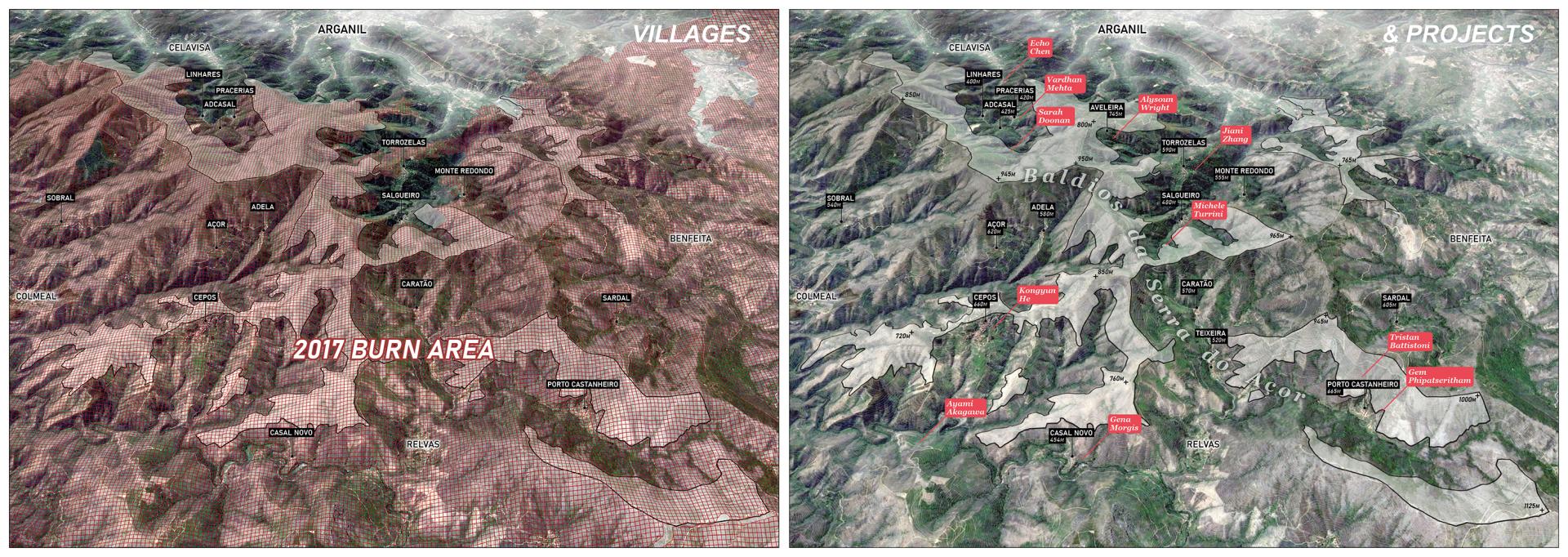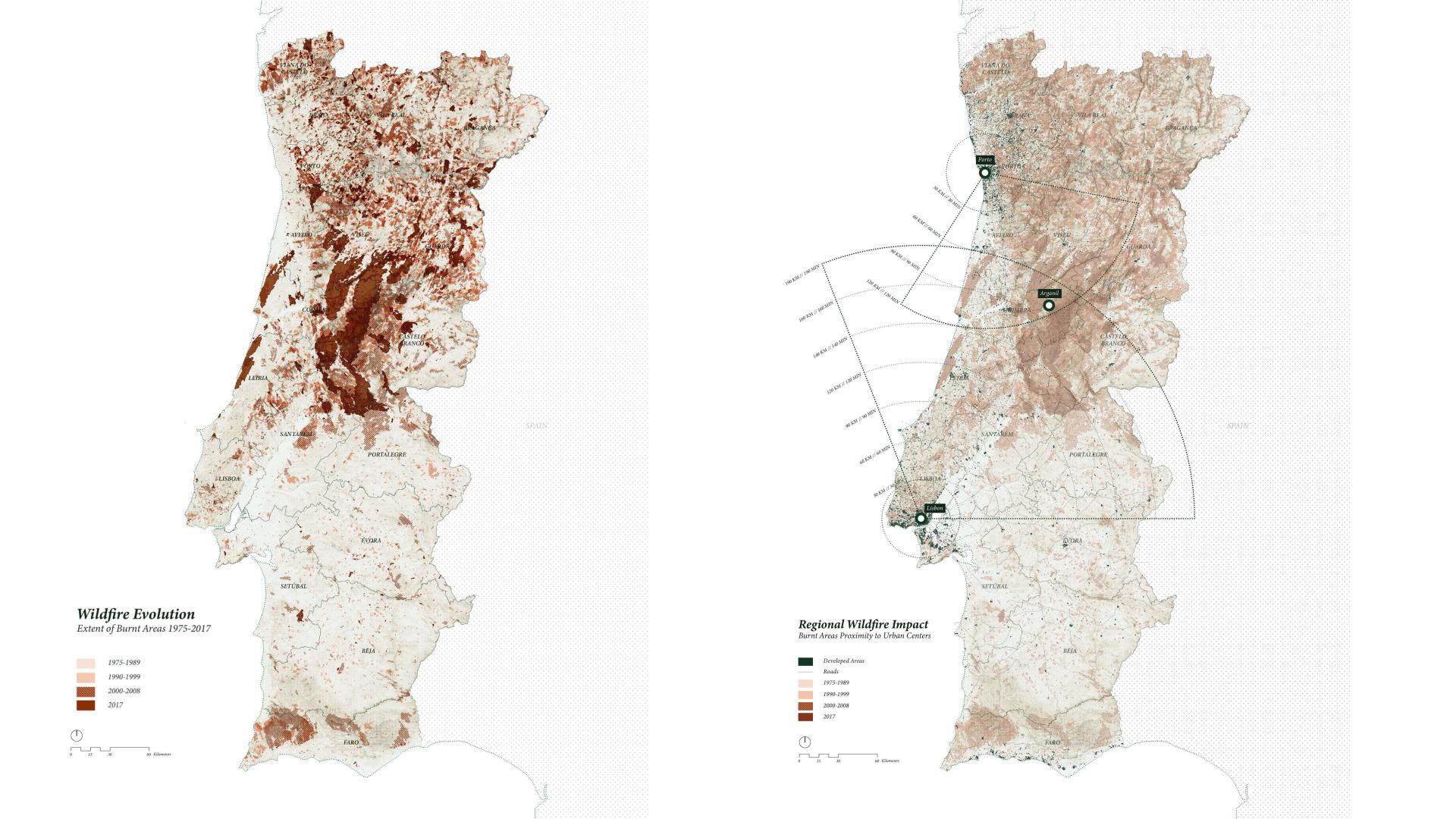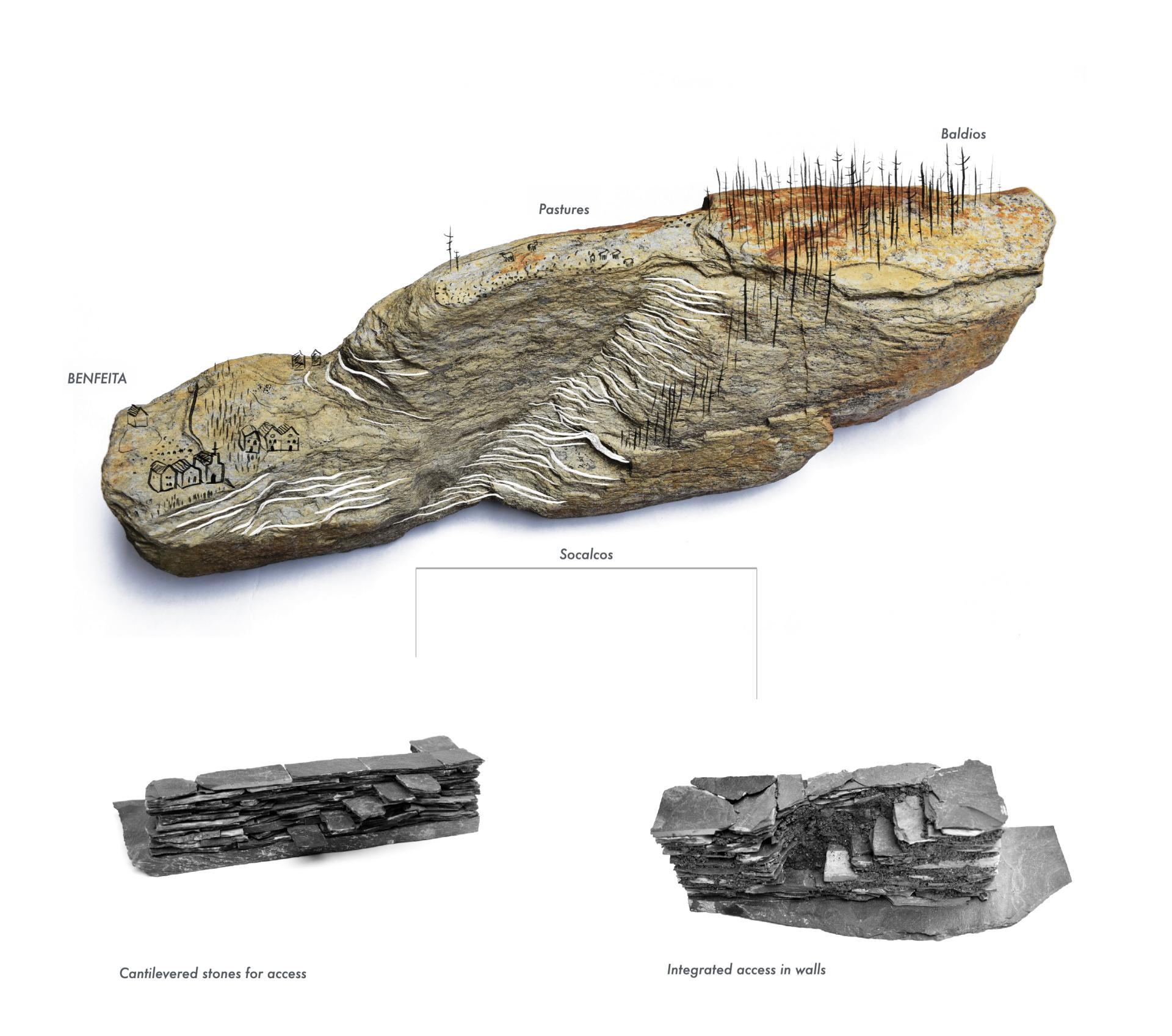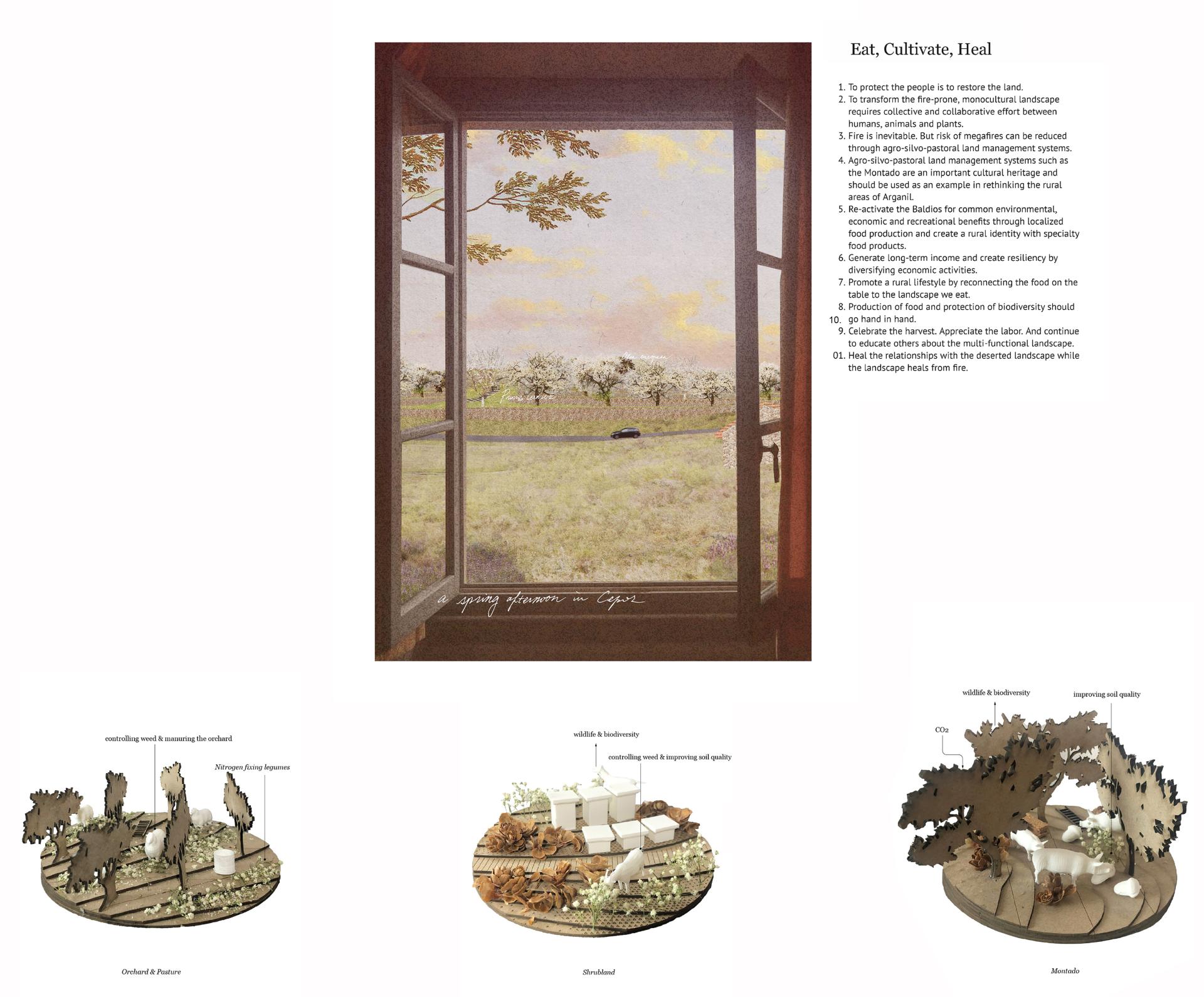Canary in the Mine
Basic information
Project Title
Full project title
Category
Project Description
Wildfires rage throughout the rural territories in the world resulting in severe economic, social, and environmental damages. With approximately ⅔ of the Portugal's territory considered “rural,” the symptoms of current wildfires are a warning of what the future holds for Mediterranean landscapes and their communities. The inter-disciplinary Studio developed at the Harvard GSD was conceived as a “laboratory” focused on rural territories, their disenfranchised communities and overlooked landscape.
Project Region
EU Programme or fund
Description of the project
Summary
Wildfires rage throughout the rural and peri-urban territories in the world, particularly in the Mediterranean climate regions (MCRs), resulting in severe economic, social, and environmental damages. Current climatic projections anticipate the swelling of these pyric occurrences, and some authors claim that humanity will enter into a new Pyrocene era. Once a necessary disturbance for landscape and cultural practices in the Mediterranean ecosystems, fire has been criminalized through policies of suppression and combat. The new magnitudes of wildfires are an accelerating threat rooted in many detrimental fronts accrued over decades triggered by land use changes and globalizing markets. However, the growing costs of wildfire combat, climate disintegration, and bio-diversity loss have catalyzed the EU to act toward new economic and ecological paradigms. Hence, the unrecognized potential of rural territories—their communities and regenerative practices—are of strategic value for the future under the recently established European Green Deal. Portugal’s rural territory affected by this pyric crisis, notably in 2017, is a warning and a prospect of what the future holds for Mediterranean landscapes and a spring-board for new planning-design principles. The CANARY IN THE MINE is a research and design studio developed at the Harvard GSD in collaboration with the local government of Arganil, severely affected by the wildfires of 2017. The studio was focused on network of 12 villages contiguous to a 6000 Ha of common land. Following the questions Why (it happens) and How (can design contribute), the 14 week project sequence foregrounded the inter-disciplinary symbiosis between living forces (people, animals and flora) and their environments. Students from landscape architecture, architecture and planning worked with the local residents and various local experts to re-imagine resilient rural landscapes, including projecting integrative community-based fire management.
Key objectives for sustainability
Wildfires are an ecological and social crisis expected to grow worldwide. While wildfires are considered a ruthless occurrence, there are also the “good” fires—namely, the low temperature burnings integral to eco-cultural practices of rural communities for landscape stewardship and pastures’ rejuvenation. The research and design studio developed at the Harvard GSD followed an inter-disciplinary pedagogical sequence focused on understanding the causes of wildfires beyond the largely accepted connection to the global rise of temperatures globally. The wildfire crisis from 2017, affecting many European countries in Europe, with particular incidence in Portugal, brought to the spotlight the unsustainable practices and detrimental fronts accrued over decades in the rural hinterlands. Amongst these are ad-hoc forest governance, fast-growing monocultures, rural exodus and the dissolution of agro-silvo-pastoral practices, criminalization of cultural burnings, decreasing summer rainfall and swelling annual temperatures, and administrative abandonment. These factors have transformed these landscapes, depending on “good” fire for its ecological equilibrium, into tinder boxes. As Stephen J. Pyne writes, “Fire is a phenomenon that derives from its circumstances... It synthesizes its surroundings.” The CANARY IN THE MINE focused on deciphering these complex circumstances by reclaiming fire as an eco-cultural agent and a benign process integral to the traditional ecological knowledge (TEK). In studying fire’s eco-cultural potential, the studio foregrounded other objectives, such as learning to live-with-fire, re-imagining the rural territory in its multi-domain potentials, empowering traditional fire knowledge (TFK) central to local landscape management, recognizing of local communities’ environmental stewardship for conserving biodiversity and securing food sovereignty via regenerative agro-silvo-pastoral activities—in which “good” fire is a productive process.
Key objectives for aesthetics and quality
While key objectives of CANARY IN THE MINE were catalyzed by the re-definition of fire as an eco-cultural agent, the pedagogical sequence was committed to foregrounding the role of design in planning the rural landscapes and in triggering change toward recognizing aesthetically and experientially such territories beyond detrimental perceptions. Described by Rem Koolhaas in his recent publication Countryside: A Report, the rural landscape has been the cities’ “back of the house” subject to most powerful events—ecological depletion, social exodus, extractive activities, aging population, and wildfires—conducted by contemporary market forces. CANARY IN THE MINE is an aesthetic project where notions of reciprocity replace the extractive; where the disenfranchised communities and their traditional fire knowledge are recognized as guardians. The Studio focused on the production of projects—drawings and narratives—able to stir desire for these areas; able to bring closer the urban communities and governmental institutions, deciding from afar on the future of these territories, through the power of imagination. Each project, presented through the form of an ALMANAC, gathered a package of research connecting seemingly disparate topics in the region (associated with the increasing wildfires) and a descriptive set of drawings rooted in local practices and contextualized in the current challenges. Rather than a romanticized view of the rural lands, each project was associated with the experiential dimensions of opportunities for regenerative practices, health services and gastronomic exchanges—all activities that trigger the senses, and simultaneously supports local economies. Therefore, an intense emphasis was set in the spatial definition of each project: its atmospheric qualities and local characteristics. This also included the depiction of the eco-cultural and spatial dimension of the “good” fire—the warden for landscape restoration and community gathering.
Key objectives for inclusion
The CANARY IN THE MINE is a research and design studio made in collaboration with the local government of Arganil in Portugal, one of the most severely affected rural areas during the tragic wildfires of 2017. The studio resulted from a long-standing collaboration initiated immediately after these events in the region. Silvia Benedito, a professor in the Department of Landscape Architecture at the Harvard GSD, established a Community Fellowship between the University and the local government to address a recurring omittance in the post-fire technical reports produced by the national government, such as local communities’ knowledge and experience. The objectives of such fellowship and the following Studio, CANARY IN THE MINE, were to foreground the role of the local communities’ knowledge in landscape management through “good” fire practices; to gather local knowledge for sustainable and integrative rural territories; to include the communities’ concerns in a continuous governance abandonment; and, to bring local challenges, apprehensions, and potentials to the core of the design disciplines as a trampoline to reach out larger audiences. The Fellowship initiated the field research in the village of Benfeita and contributed to the post-tragedy recovery of the community. After holding trust from the community, the following CANARY IN THE MINE developed design proposals for a network of neighboring 12 villages. The Studio curricula was organized around goals set by the communities and the local government. The results of CANARY IN THE MINE will be shared with the larger audiences in the upcoming September in a form of an itinerant exhibition throughout the 12 villages. Here, the local communities will lead the process of communicating the design ambitions of each projects for their villages. The goal of this initiative is to give voice to the unheard communities through projects imagined for them, their local challenges, potentials, and importantly, new futures.
Results in relation to category
The CANARY IN THE MINE research and design studio was conceived as an inter-disciplinary “laboratory” focused on rural territories, their disenfranchised communities and overlooked landscapes. Due to the current worldwide scale of occurrences, this studio set the beginning of a long-term pedagogical sequence named “Cycle of Fire” as to embrace comparatively other regions subject to similar challenges: California, Australia, Sub-Saharan Africa, South America, and Europe. The complexity of the wildfire crisis set forth an interdisciplinary approach exposing the students to a 14-week sequence with multiple voices and experts. This included experts in climate (impacts of climate change in the MCR’s regions), Portugal’s history (agricultural development and forest engineering practices), fire ecology (fire’s behavior, weather and pyric-diversity), carbon credits’ programs (emerging carbon markets for alternative income streams in local initiatives), local governance (territorial policies and institutional fire suppression), local artist (focus on post-recovery techniques) and lastly, local communities and shepherds of the region conducting landscape management with their goats’ herds. The impacts of this pedagogy were felt on the number of new studies and design thesis developed at the Harvard GSD focused on rural areas and on the embracing of “good” fire as a beneficial eco-cultural process. The CANARY IN THE MINE promoted also the learning of fire suppression policies beyond the rural communities as to include the indigenous groups worldwide in a comparative manner. While fire suppression policies dismantled many traditional landscape management practices in the core of traditional communities due to globalizing markets, the same suppression impetus, in the core on indigenous communities, revealed the engrained dispossessive practices core to colonial procedures—as evident in the First Nations’ territories of California, British Columbia, and Australia.
How Citizens benefit
The CANARY IN THE MINE studio followed a Fellowship established between the Harvard GSD and the Municipality of Arganil in 2018 in consequence of the 2017 devastating wildfires. More than 520,000 hectares in the Municipality of Arganil alone (60% of the total EU burnt areas in 2017) succumbed to the strength of a new typology of wildfires, the megafires. Arganil’s rural territories and isolated communities were severely affected, creating additional trauma to the prevailing sense of social abandonment from the national government. In the wake of these events, the Harvard GSD engaged with a post-recovery strategy by developing participatory field research with the local populations. This included the documenting of the communities’ regenerative practices, traditional knowledge on landscape management (TEK) and traditional fire knowledge (TFK) for reducing fuel, currently criminalized by suppression policies. Furthermore, it included the identification of landscape-built structures and the making of collaborative models (see submitted drawings) for documenting local techniques and civic uses. Amongst these were the network of landscape terraces made with local stone—once vital for the regenerative agricultural practices and essential in retaining nutrients and humidify in the soil. While in growing disrepair, these structures were identified by the local communities as essential for the territory’s resiliency against the ever-growing pyric threats. These actions generated a strong sense of cooperation amongst the dispersed villages and provided an opportunity for the community to share their knowledge. This knowledge and the community suggestions were further expanded in the CANARY IN THE MINE studio toward possible futures of the rural hinterlands. The communities will present the resulting design scenarios in an itinerant exhibition throughout the network of Arganil’s villages in September 2021 with the presence, and political commitment, of the national government.
Innovative character
The innovative character of this project lies on the topics, communities and methodology. It concentrated on possible futures for the rural territory in lieu of the dominant discussion on urban challenges. It brought Traditional Ecological Knowledge (TEK) to the fore and it put a spotlight on the role of fire in regenerative landscape practices and community livelihoods. Embracing fire as an eco-cultural agent, meant also breaking detrimental preconceptions engrained in colonizing procedures and globalizing forces. The CANARY IN THE MINE catalyzed a deeper research on the causes of the current wildfire scales and magnitudes. With the support of local experts, the affected communities, and specialists from other regions subject to similar challenges, the Studio gathered a series of shared deductions and goals. Amongst the deductions was that fire is a necessary and prevalent phenomenon in the Mediterranean climate regions landscapes. Rather than policies of suppression, and the costly combat mechanisms, a bigger effort must be steered in integrating community fire-management. Fire is not always “bad” as one may consider in the urban contexts or industrial forestry. It depends on the scale and temperatures. In the rural contexts and indigenous lands, “good” fire is integral to the everyday livelihoods. It is essential for managing the landscape loads and form discontinuous mosaics; it is central in providing dietary and medicinal components; and, it is core to managing grasslands for attracting prey. Furthermore, it is vital for the spiritual and emotional wellbeing of many communities worldwide. Policies of fire suppression have disrupted the multifold benefits provided by the “good” fire, leading to social dispossession and the current wildfire crises. The research and design work produced in CANARY IN THE MINE disclosed these hidden realities, showcasing that design has the power to question the status-quo leading, and imagining, more integrative practices.





